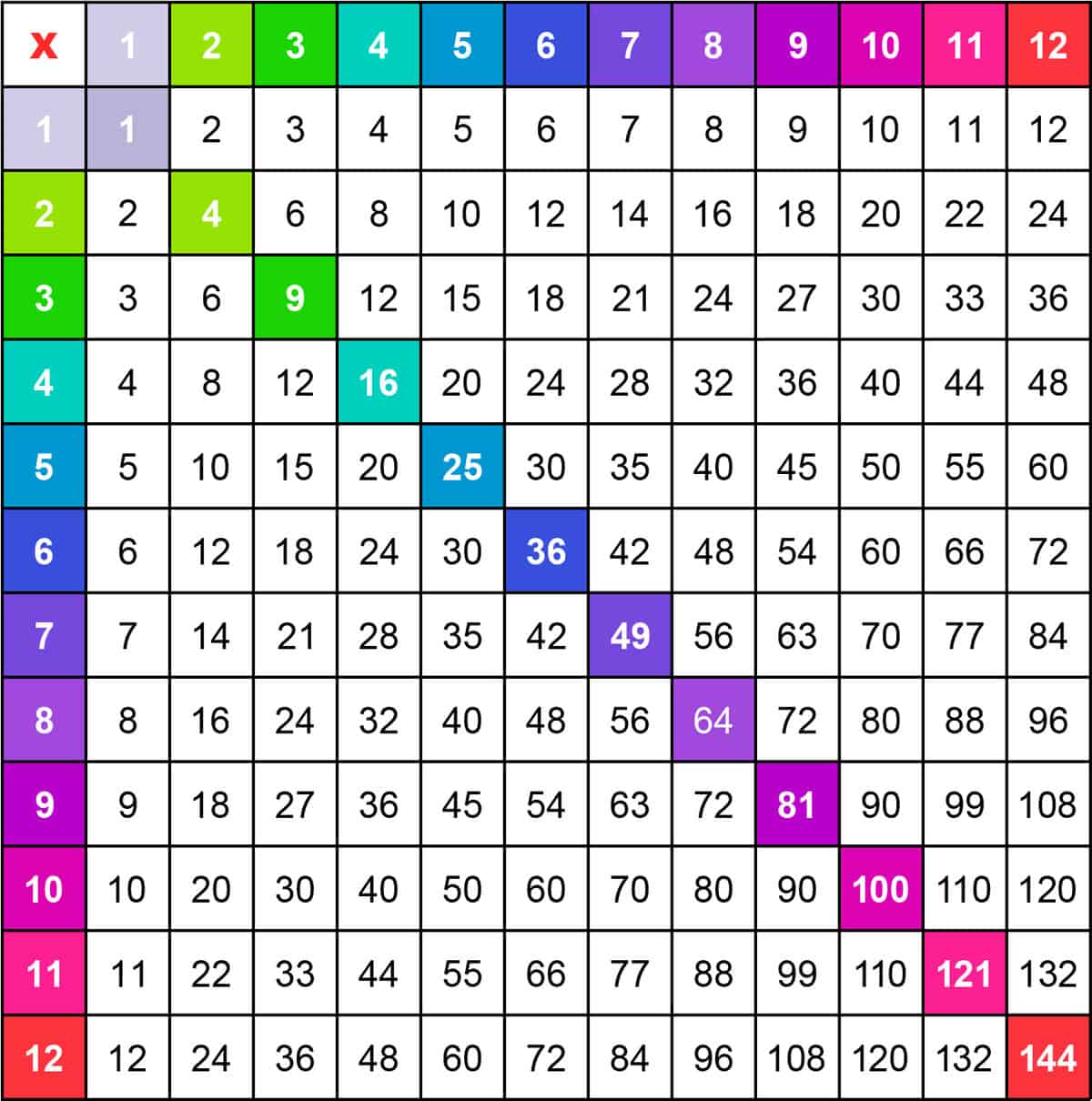Mastering Math Magic: Your Ultimate Guide to the Multiplication Chart
Hello there, wonderful parents! Are you ready to watch your children transform into little math whizzes right before your eyes? Well, buckle up because we’re about to take a magical math ride into the world of multiplication charts! Whether your kiddo is just stepping into the world of multiplication or looking to sharpen those rapid-fire calculation skills, we’ve got the perfect guide for you.
? What is a Multiplication Chart?
Imagine a treasure map that leads to countless math victories—that’s what a multiplication chart is for your kids! It’s a grid that displays the result of multiplying two numbers. Typically, it’s set up with the numbers 1-10 or 1-12 across the top and down the side, but some charts go even higher to really challenge those brain muscles!
? Why is a Multiplication Chart Important?
Ever seen a little one’s face light up when they solve a problem on their own? That’s the kind of confidence a multiplication chart builds. It’s not just about memorizing numbers; it’s about understanding patterns, accelerating mental calculation, and laying a strong foundation for more challenging math concepts that come later on. Plus, it saves time and anxiety during homework, tests, and real-world scenarios.
Let’s not forget that being friendly with numbers can boost overall academic confidence and can be a real game-changer in careers that are staring down the line. Whether it’s engineering, finance, sciences, or arts, numbers pop up more often than Pop-Tarts in a toaster!
- Fosters Independence: Kids can use the chart as a reference instead of always relying on a calculator or a parent—talk about empowerment!
- Improves Memory: Constantly seeing and using the chart helps kids recall multiplication facts quickly.
- Better Understanding: It helps children see the relationship between numbers and grasp concepts like skip counting, even/odd numbers, and patterns in math.
- Prepares for Advanced Math: Multiplication is foundational; it’s the building block for division, fractions, algebra, and beyond. A strong multiplication understanding sets up success for the future.
? How to Introduce Your Child to the Multiplication Chart
Alright, so you’ve got a chart in your hands—what’s next? Starting can be as sweet as a slice of pie, and here’s how!
- Start with a story: Make it fun! Create a tale about why the numbers like to play together. Kids love stories and it can make the introduction memorable.
- Walk through the chart: Before jumping into the deep end, start by simply going through the chart with your child, discussing the layout, and ensuring they understand its structure.
- Focus on the easy bits: Show them the patterns first—the multiples of 1 (which stay the same), of 10 (just add a zero!), and of 5 (the alternating number dance).
- Use colors and stickers: Kids adore colors and stickers! Use them to highlight patterns or to reward progress on different multiplication families.
Remember, patience is key. Each child learns at their pace, and it’s just fine if it takes a few tries to get those numbers dancing in their heads!
Inculcating the love for numbers and making multiplication a cakewalk could just be the confidence booster your children need. And guess what? It doesn’t end here! Keep reading as we delve deeper into creative ways of teaching, fun activities, and sneaky math multiplication chart tips that will have your child mastering those numbers like a pro in no time!
Stay tuned as the next section promises to sprinkle a little extra math sparkle, giving you insight into delightful multiplication games and activities. After all, who said learning can’t be an adventure filled with joy and discovery? Let’s make those numbers work for us and not the other way around!

? 5 Essential Tips for Parents Preparing a Multiplication Chart
Before you help your child dive into the waters of multiplication mastery, here’s what you as a parent should know to make the journey smooth sailing:
- Patience is a Virtue: Learning multiplication is a process that may take some time. It’s essential to be patient and encouraging as your child familiarises themselves with the concept.
- Consistency is Key: Establish a routine for practicing multiplication. Designate a specific time each day for your child to interact with the multiplication chart. Regular practice will reinforce their understanding and retention.
- Positive Reinforcement: Celebrate the small victories. Whether they’ve mastered the table of 2 or dashed through the 9’s with ease, ensure praise is part of the learning process to build confidence.
- Real-Life Application: Make multiplication relevant by showing your child how it appears in everyday life. This could be anything from calculating the total cost of groceries (5 packs of gum at $2 each) to baking (doubling a recipe).
- Customizable Charts: Adapt the chart to your child’s learning style. If they are visual learners, incorporate more colors and images. If they are kinesthetic learners, incorporate physical gestures or moves that correspond with the multiplication facts they’re focusing on at the moment.
Now that you’re armed with these foundational tips, let’s delve a little deeper into each one:
Patience is a Virtue: Remember that every child’s pace of learning is different. While some might catch on quickly, others might need to wrestle a little longer with the concept. Praise effort over perfection, and know that with time and practice, they will get there. Avoid comparing siblings or peers, as each child is unique in their learning journey.
Consistency is Key: Like watering a plant, consistent effort yields growth in knowledge. It may feel repetitive, but daily engagement with the multiplication chart cements the familiarity and creates muscle memory for the mind. Incorporate variety in the daily practice sessions, using games, timed challenges, or flashcards to keep things interesting.
Positive Reinforcement: Positive reinforcement can be manifested through verbal praise, stickers, or a points system that leads to a small reward. This doesn’t mean that you should tolerate inaccuracies or gloss over mistakes, but rather, gently guide and correct them with encouragement.
Real-Life Application: Math doesn’t have to stay on paper; it’s all around us! Use cooking, shopping, or even road trip games to apply multiplication in a practical, tangible way. Ask questions like “If we have 4 bags and there are 6 apples in each bag, how many apples do we have in total?” to get them thinking multiplicatively outside the classroom.
Customizable Charts: A visual learner might benefit from a color-coded chart where multiples of the same number are in the same color, making patterns easily recognizable. You could even create a poster-sized chart to hang in their room for continuous visual input. For kinesthetic learners, turn it into a hopscotch game where they jump to the right answer, getting their entire body involved in the learning process.
Embracing these tips will create a nurturing environment that can help your child fall in love with math, or at the very least, not feel defeated by it. With your guidance and the secrets of the multiplication chart, math can become a welcome challenge rather than a daunting task. Let’s keep our eyes on the prize: raising confident, self-assured mathematicians who are not afraid to tackle problems and seek solutions!
So dear parents, go forth and chart the wondrous land of multiplication with your kiddos. With these tools in your arsenal, you’re more than equipped to guide them through their math adventures, forging paths to success one number at a time!
For more great fun click here. For more information see here
Disclaimer
The articles available via our website provide general information only and we strongly urge readers to exercise caution and conduct their own thorough research and fact-checking. The information presented should not be taken as absolute truth, and, to the maximum extent permitted by law, we will not be held liable for any inaccuracies or errors in the content. It is essential for individuals to independently verify and validate the information before making any decisions or taking any actions based on the articles.




